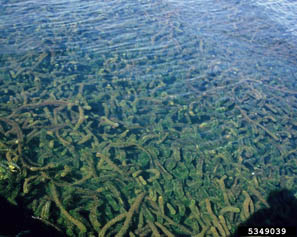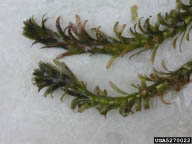Invasive Species Spotlight: Brazilian Elodea (Egeria densa) | |
|---|---|
| August 22, 2008 | |
|
Brazilian elodea, or Brazilian water-weed, can often be found for sale in pet stores, where it is used as décor and habitat-enhancement material for freshwater aquariums. When it is carefully restricted to the tanks it was intended for, it isn’t a concern of land and wetland resource managers. The problem is when the plant becomes introduced to natural wetlands and lakes. Here, it can grow very quickly and dominate the subsurface landscape, altering habitat for fish and wildlife by displacing native plants and manipulating water quality. These ecosystem-changing qualities have made it a plant of top concern for all interested in wetland resource management.  Brazilian elodea, photo courtesy of Leslie J. Mehrhoff, University of Connecticut.  Brazilian egeria, photo courtesy of William T. Haller, Bugwood.  Photo courtesy of Leslie J. Mehrhoff, University of Connecticut. This subsurface aquatic plant is native to Brazil, Argentina, and Uruguay. Because it has been traded and used in freshwater aquariums, it can now be found worldwide—including several countries in Europe and Asia; Australia and New Zealand; as well as spread throughout South and North America. In the United States, it can be found from coast to coast, being fairly common in the southern states, with isolated infestations in other areas. It has been found in several counties in the southern portion of Illinois. Brazilian elodea can be found growing in open ponds and lakes, old reclaimed quarries, slow-moving streams, and wetlands. It can be found growing at depths of up to 20 feet. Its only primary form of spread is through introductions from unwanted aquarium waste and fragmentation, whereby a portion of the plant becomes separated from the main plant and floats away or roots in a new area. Elodea is dioecious, with all the plants found in the United States thought to be males; it is not know to spread through seed production. As the plant can grow very rapidly in new areas, it can quickly outcompete native plants for space. It also can slow down or alter water flow, thereby trapping sediment and creating stagnant pools, often place where mosquitoes and other pests can breed. It is also a problem for aquatic recreationists, often being difficult to paddle or fish through. It can be identified by the leaves and stems. Its leaves grow in whorls around the stem in groups of four to eight. They are oblong to linear, about 1 inch long and 1/4 inch wide. The margins have very fine serrations that may be difficult to see. Brazilian elodea may flower from spring and early summer, with sporadic flowers up into the autumn. Each three-petaled white flower is held above the water’s surface on a fine stalk up to 3/4 of an inch in diameter. It can be confused with American Elodea (Elodea canadensis), which can look very similar but has leaves whorled usually in groups of threes that are only 1/2 inch long. Additional information for Brazilian elodea can be found at USDA Plant Profile: http://plants.usda.gov/java/profile?symbol=EGDE.(Mike Garrett) | |
| Author: | Mary Overmier |
